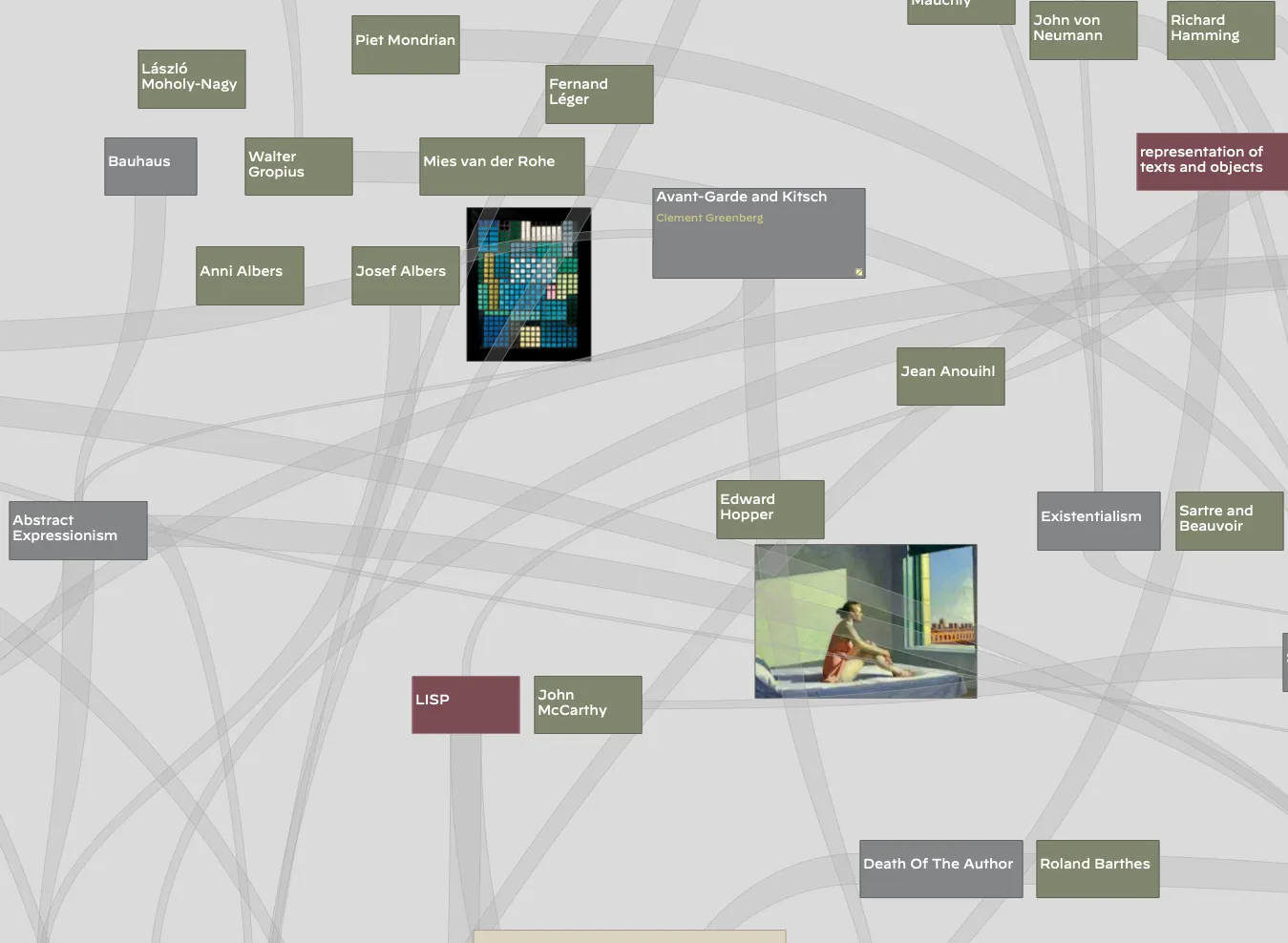Thoughts On Graphs
An email list I’m on (how quaint!) has been discussing moving the idea plane (e.g. the Tinderbox map) into three dimensions.
Bjørn Borud wrote:
I don't find graphs to be a particularly useful visual representation of knowledge. You can only meaningfully view them if they have few nodes. And no real-world graphs I've dealt with are small enough to view meaningfully. For those to be useful as a way to view the information you have to prune and abstract them. And even then, they do not lend themselves to rapid, intuitive understanding. Perhaps because automatic layout of graphs is a hard problem.
I have some thoughts.
1. Automatic layout of spatial hypertext graphs is usually a mistake. But there is no inherent need for automatic layout, as Storyspace showed 30 years ago.
Joyce, M. (1991). Storyspace as a hypertext system for writers and readers of varying ability. In Hypertext '91 Proceedings (pp. 381- 387). San Antonio: ACM.
Bernstein, M. (2002). Storyspace 1. In Proceedings of the 13th ACM Hypertext Conference, K. A. Stuart Moulthrop, and Jamie Blustein, eds. (pp. 172-181). College Park, Maryland: ACM.
2. Assistance in layout of spatial hypertext is certainly useful. Spatial parsers are one approach:
Marshall, C. C., & Shipman, III., Frank M. (1997). Spatial hypertext and the practice of information triage. In Proceedings of the eighth ACM conference on Hypertext (pp. 124-133). Southampton, United Kingdom New York, NY, USA: ACM.
Shipman, F., Hsieh, H., Airhart, R., Maloor, P., & Moore, J. M. (2001). The Visual Knowledge Builder: A Second Generation Spatial Hypertext. In Hypertext 2001: Proceedings of the 12th ACM Conference on Hypertext and Hypermedia, Hugh Davis, and David G. Durand eds. (pp. 113-122). Århus, Denmark: ACM.
Roßner, D., Atzenbeck, C., & Brooker, S. (2023). SPORE: A Storybreaking Machine. Proceedings of the 34th ACM Conference on Hypertext and Social Media, p. 1
An alternative approach, adopted in Tinderbox (https://www.eastgate.com/Tinderbox/), moves the spatial parser to the drag handler. Local geometries are induced on the fly, and suggestions expressed as “snap-to-alignment” forces.
3. There’s rather a lot of research on finding meaning in the knowledge plane cataloged under of “art: modernism.”

Bernstein, M. (2023). The Indefinite Idea Plane Artistically Considered. International Journal of Design Sciences and Technology, 25(2), 1-10.
Information Architecture has predominantly followed Walter Gropius and Mies van der Rohe; I think we ought to be looking toward Louis Sullivan and Antoni Gaudí, El Lissitzky and Jackson Pollock.
Spuybroek, L. (2016). “The Digital Nature Of Gothic”, The Sympathy of Things. (London: Bloomsbury Publishing)
4. The goal of “rapid, intuitive understanding” is difficult to sustain. Computing is the last refuge of faith in structuralism, the conviction that all problems can be represented simply if we can discover the correct coordinate system. The universe might not work that way. Roman Jakobson and Claude Lévi-Strauss thought that perhaps it did, and that finding a good representation would lead to systems of human science as regular as group theory or statistical mechanics. If that is not in fact the case, we shall have to work with the universe we have, not with the one for which once we longed: see also the emptiness of our sky. Compare the early chapters of Red Plenty, which envision a breakthrough on operational programming discovered by a Soviet mathematician in the years immediately after WW2 and which led to a world in which the efficiency of planned economies outran the outmoded chaos of capital markets.
Spufford, F. (2010). Red plenty. (New York: Faber and Faber)
5. The intuition that three-dimensional representations will unlock The One True Representation Of Knowledge (TOTROK) is certainly attractive. What we can perceive, however, is a plane with some modest additional data from binocular vision. A surprising number of people don’t have effective binocular vision, and some don’t even know it. The difficulty of flying through information spaces was first discussed by Steve Poltrock and his colleagues at Boeing: it’s actually quite difficult to get student fighter pilots to think outside the plane. (I’m not sure I have the correct reference here.)
Fairchild, K. M., Poltrock, S. E., & Furnas, G. W. (1988). SemNet: three-dimensional graphic representation of large knowledge bases. in R. Guinon (ed.), Cognitive Science and its Applications for Human-Computer Interaction (pp. 201-233). Lawrence Erlbaum.
6. Some ancient certainties of interface design might be reconsidered. We assume that things will stay where we put them. We assume our boxes have edges and that edges are never lost. Few user interfaces make much allowance for multivalence, but multivalence is not a vice: it is necessary and ubiquitous. We have been saying that “everything is intertwingled!” since 1984, but it seems that we don’t want to believe it.
Bernstein, M. (in press) Thinking With Tinderbox, (Watertown: Eastgate Systems)
7. Though we might not be able to find simple representations for “everything known about computer science” or “the rights of man,” we must nonetheless, somehow, decide what we will work on next. That choice must be made, even though we cannot foresee all ends. Sartre’s student asks whether he should go overseas to join the Free French, or stay and fight in the resistance. We cannot know enough, and all courses may run ill, but despite it all we have to choose what to do with the time that is given us. Though grand totalizing structures might not exist, we can find meaning in the subgraphs of knowledge neighborhoods. That may be enough to let us decide: it may have to be.
Things Tinderbox thinks might be related: